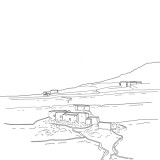Supervisor:
2024
The subject of this research project is the analysis of the farmsteads of Mykonos. With slight intervention and limited resources, the island's residents sought ways to appropriate the surroundings and exploit the land. In order to survive in this rocky terrain, they constructed structures based on their daily functions and local materials. They observed the place, understood its characteristics, and ultimately developed techniques fully adapted to their needs. Thus, the Mykonian horio was created, the concept of which surprises anyone encountering it for the first time. Despite expecting to find a settlement, one faces a fully autonomous complex of buildings, organized around a single-family residence.
The changes that have occurred in modern daily life, combined with the evolution of tourist activity, have resulted in the decline of older structures. They stand neglected, lifeless, reminding ghosts of the past, which are heading towards oblivion.
The study aims to highlight a different perspective of the island, away from the usual stereotypes. The various values of rural life are examined, within the context of the island’s climate and social conditions, as revealed by the abandoned shells of old horio. Through architectural and photographic representation, as well as the audio recording of the testimonies of local people, belonging to different professional domains, a comprehensive picture of the past reality emerges.
The following texts and blueprints of representations attempt to bring to the forefront traces of a routine that has almost disappeared. Ultimately, this is an attempt to strengthen the memory of previous generations and transfer knowledge to the following ones.
